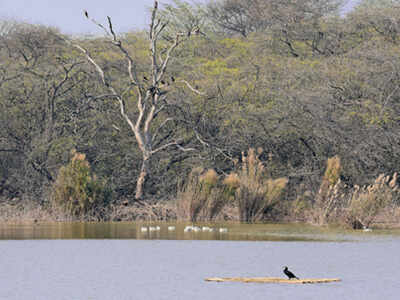
CHANDIGARH: Sukhna’s rising water level has dipped the count of winged visitors, so in the next migratory-bird winter, the administration plans to make the regulator end shallow and add fish to the lake to lure these cranes and diving ducks.
UT environment director Debendra Dalai has confirmed the decline and said: “The effort is always to have shallow water. But now as a permanent solution, we plan to divide the lake in two. The main part will be kept deep for boating, while the regulator end will be maintained shallow to attract migratory birds. At the regulator end, we will add some fish and plants that birds like.”
The department tried this method at Nagar Van (city forest) and succeeded in drawing a greater number of migratory birds from last year. Dalai said.
“At Nagar Van, we have created a water body only two-tothree feet deep. In it, we released some fish and planted grain stalks of bajra. In the first season in 2018-19, not many birds came to this water body but, this year, the numbers went up.”
Chandigarh is on the flight path of many migratory birds that start their long flight every winter from the Himalayas and far-off Central Asia, Siberia, Europe, China, and Japan. These winged guests start arriving in the city as early as November and stay on till March. For their safe stay and well-being, the shallow water and weeds towards Sukhna wildlife sanctuary were a blessing in disguise. However, in the past few years, as the water level of the lake increased and food became scarce for these shallow divers, they moved to Mote Majra and Chhatbir.
Environmentalist Kulbhushan Kanwar said: “When there was not enough water in the Sukhna, many migratory birds used to visit the lake. Due to a plenty of rainfall in the last two years, these birds do visit the lake but not stay. There is a great need for a shallow wetland. Recently, I suggested to the environment department to build some floating islands where birds could rest. I am happy that this experiment worked. Another idea is to pump out surplus water into the main lake and bar the rowing team from some sections to keep the birds undisturbed.”
Kanwar said: “The exact reduction in the bird count is unclear but 24 species of migratory birds that come to Chandigarh every year include common pochard, ruddy shelduck, common coot, greater cormorant, purple heron, and oriental pied hornbill. They fly like a rollercoaster in a ‘V’ formation and keep changing their leaders while crossing over the lofty Himalayan peaks.”
The Chandigarh Bird Club will do a bird census at the end of February, says club president Mitinder Sekhon.
The club had raised the alarm about the flight of winged visitors.
UT environment director Debendra Dalai has confirmed the decline and said: “The effort is always to have shallow water. But now as a permanent solution, we plan to divide the lake in two. The main part will be kept deep for boating, while the regulator end will be maintained shallow to attract migratory birds. At the regulator end, we will add some fish and plants that birds like.”
The department tried this method at Nagar Van (city forest) and succeeded in drawing a greater number of migratory birds from last year. Dalai said.
“At Nagar Van, we have created a water body only two-tothree feet deep. In it, we released some fish and planted grain stalks of bajra. In the first season in 2018-19, not many birds came to this water body but, this year, the numbers went up.”
Chandigarh is on the flight path of many migratory birds that start their long flight every winter from the Himalayas and far-off Central Asia, Siberia, Europe, China, and Japan. These winged guests start arriving in the city as early as November and stay on till March. For their safe stay and well-being, the shallow water and weeds towards Sukhna wildlife sanctuary were a blessing in disguise. However, in the past few years, as the water level of the lake increased and food became scarce for these shallow divers, they moved to Mote Majra and Chhatbir.
Environmentalist Kulbhushan Kanwar said: “When there was not enough water in the Sukhna, many migratory birds used to visit the lake. Due to a plenty of rainfall in the last two years, these birds do visit the lake but not stay. There is a great need for a shallow wetland. Recently, I suggested to the environment department to build some floating islands where birds could rest. I am happy that this experiment worked. Another idea is to pump out surplus water into the main lake and bar the rowing team from some sections to keep the birds undisturbed.”
Kanwar said: “The exact reduction in the bird count is unclear but 24 species of migratory birds that come to Chandigarh every year include common pochard, ruddy shelduck, common coot, greater cormorant, purple heron, and oriental pied hornbill. They fly like a rollercoaster in a ‘V’ formation and keep changing their leaders while crossing over the lofty Himalayan peaks.”
The Chandigarh Bird Club will do a bird census at the end of February, says club president Mitinder Sekhon.
The club had raised the alarm about the flight of winged visitors.
Get the app









